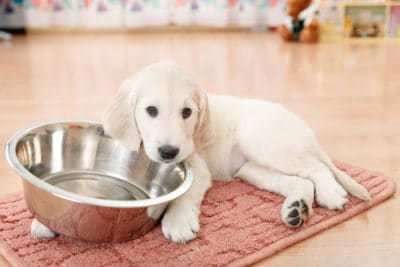
When you bring your new puppy home, it’ll be around 8-12 weeks old untrained or approximately 5 months of age trained. While weaning off mother’s milk is already taken care of at around 8 weeks of age, a puppy feeding schedule will be an important learning curve for you and your pup, along with potty training, playtime and house training.
When it comes to balanced nutrition, the first year of your dog’s life sets it up for how it approaches food intake, sticking to a regular feeding routine and ensuring it’s a healthy weight.
By meeting your puppy’s needs perfectly during the initial stages of development, you’ll make life better for your dog and easier for you. Read on to learn more about giving the right puppy feeding schedule and what types of food to give.
Do Puppies Need a Special Type of Food?
Adult dog food isn’t suitable for puppies because a growing puppy needs higher quantities of specific nutrients such as protein and calcium, and fat. By choosing high-quality puppy food for your pet, you improve its quality of life. Good brands will guarantee your dog has better teeth, improved digestion, a glossy coat and a lower risk of obesity. Dog food with more natural ingredients and less preservatives and fillers are the best, so opt for these wherever possible.
Wet Food vs Dry Kibble
The most important thing is that you meet your puppy’s daily caloric needs and provide it with a complete, balanced diet. Whether you end up feeding wet or dry food — or a mixture of the two — is a matter of personal preference for your pet and you to decide upon. Make sure you check the feeding guide on the package, and make an accurate calculation based on both guidelines if you decide to feed your pup a mixture of wet and dry.
Size-Specific Puppy Food Formulas
Large-breed puppies, such as standard or medium goldendoodles, might need a different type of food compared to mini labradoodles. While this isn’t necessarily essential, it’s a great way to ensure your pup gets the right nutrients for its unique needs.
For example, larger breeds might be more susceptible to orthopedic problems, whereas small breeds have faster metabolisms and require more nutrients packed into smaller, easier-to-consume chunks of wet or dry food.
Adult weight problems usually have their roots in puppyhood, and food and activity levels are equally important when it comes to your puppy’s body condition. By being diligent with what you feed your small or large breed puppy, you give it the best chance of a long and joyful life.
Puppy Feeding ScheduleChart
How much food you give your puppy is essential to its well-being. It’s growing fast, and the puppy’s nutritional requirements are changing all the time. The most important metrics when choosing how much to feed a puppy are its age in months and the weight it’ll be as an adult dog. It’ll need a new puppy feeding schedule every few months, so make sure you’re constantly updating the amount as its needs change.
Purina has suggested the following amounts of dry kibble, but be careful to check the package of the food you opt to use, as not all kibble is the same. Wet food amounts vary significantly as well. Speak to your veterinarian if you’d like extra help putting together the optimal puppy feeding schedule.
Sample Puppy Feeding Schedule
Just like housebreaking and exercise, you should stick to a strict puppy feeding schedule when it comes to feeding time. This isn’t to be mean or boring; it’s actually one of the easiest ways to be kind to your pet. Consistency helps it feel confident and comfortable in your home, and it’ll help you get into the right habits. Try to time feeding at the most convenient times for you and routine will come naturally. Check out this sample puppy feeding schedule:
- Wake up: The first drill of the day should always be the potty. If your pup knows it gets to go out every morning, it’ll quickly learn to wait. Being consistent with toileting will make everything else easier.
- Breakfast: Prepare breakfast and ensure you don’t leave food down for more than 20 minutes so your furry friend understands how mealtimes work. Don’t feed your pup human food tidbits under any circumstances or treats in between meals unless they’re a reward. Be careful to limit how many puppy treats your pup gets each day so it stays within its recommended calories. Ensure freshwater is available with each meal.
- Exercise and play: Take pup out for the toilet again straight after breakfast, and dedicate time to play and exercise. Ideally, you should walk your dog once in the morning and once in the evening.
- Nap time: When you get back from playing, the little scamp will be ready for its first nap of the day. Even if you’re at home, we’d recommend giving your pup some time in a crate or pen so it gets used to it. Besides, new puppies are highly volatile! If you can’t watch your pet’s every move, it’s best to keep it out of trouble.
- Repeat wake-up routine before lunch: When it wakes up from its first nap, repeat the morning routine and give it lunch. Matching your eating time to the dog’s can help everyone easily maintain a consistent routine.
- Exercise and play: After food, let your pup relieve itself outside, and be sure to spend some time puppy training and playing before sending it back to bed for its afternoon nap. Even if you’ve just come indoors, we’d recommend taking it back out to its potty zone once more before bed. When it wakes up, take it to the toilet and have another play with the whole family together.
- Dinner: During dinner, it might be a good idea to put the pup in its crate so it isn’t tortured by the sights and smells and no one at the table is tempted to give out tidbits. As soon as it’s finished eating its dinner, take it outside for the most rigorous bout of exercise for the day. This is the time of day it’s usually most excitable, so give it lots of attention and a little treat before bed!
- Bedtime: Having a set bedtime makes it easier for you and your pet to go about daily life happily. There’s no particular time that’s best, just make sure it’s consistent.
- Overnight: If your dog still needs to get up in the night to potty, try to set an alarm to wake up before it does; otherwise, it’ll learn to bark or beg for attention. Don’t worry, this stage won’t last long, but it’s essential for correct housebreaking.
Your Puppy’s Nutritional Needs
Just like people, dogs need to get the perfect balance of macronutrients and micronutrients. The puppy foods you buy will have the breakdown included on the label, so you can find the fit that’s perfect for your pooch’s dietary needs.
Protein
Protein helps build and repair your dog’s skin, muscle, hair and nails — as well as contribute to other essential functions and providing energy. Meat and fish are the most digestible and natural proteins for dogs, and they tend to make up the majority of a canine diet. Lower-cost dog food might substitute meat with cheaper protein sources such as potato, maize and soya — so opt for high-quality puppy food if possible.
Fats
Fat helps keep your dog’s hair and skin healthy and provide more energy than carbohydrates and protein. Some fats, such as omega-3 and omega-6, aren’t made inside the dog’s body, but they’re essential for brain development, blood clotting and reducing inflammation.
Fiber
In the past, there was debate over whether dogs needed fiber in their diet or not. As scientists’ understanding of how the body digests fiber has evolved, they’ve realized that it’s an important part of the canine diet. It absorbs water, reducing diarrhea and preventing constipation at the same time. Many modern dog food brands contain veggies for the fiber content, so don’t worry if you see them on the label.
Are You Looking for a New Puppy to Take Care Of?
At Pride and Prejudoodles, we’re head over heels in love with dogs, and our team nurtures each pup in our care as if they were our own. Whether you’re looking to adopt a trained goldendoodle or a lovable labradoodle puppy, we’ve got a wide range of trained and untrained pups, all super-excited to find their forever home. Get in touch today to find out more.
